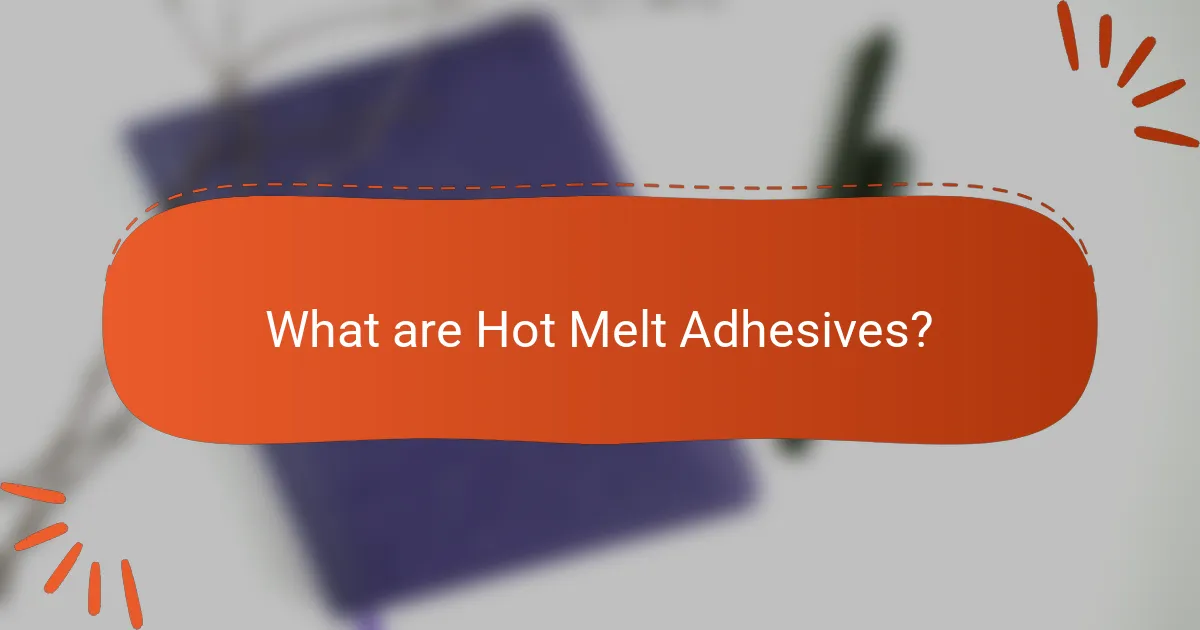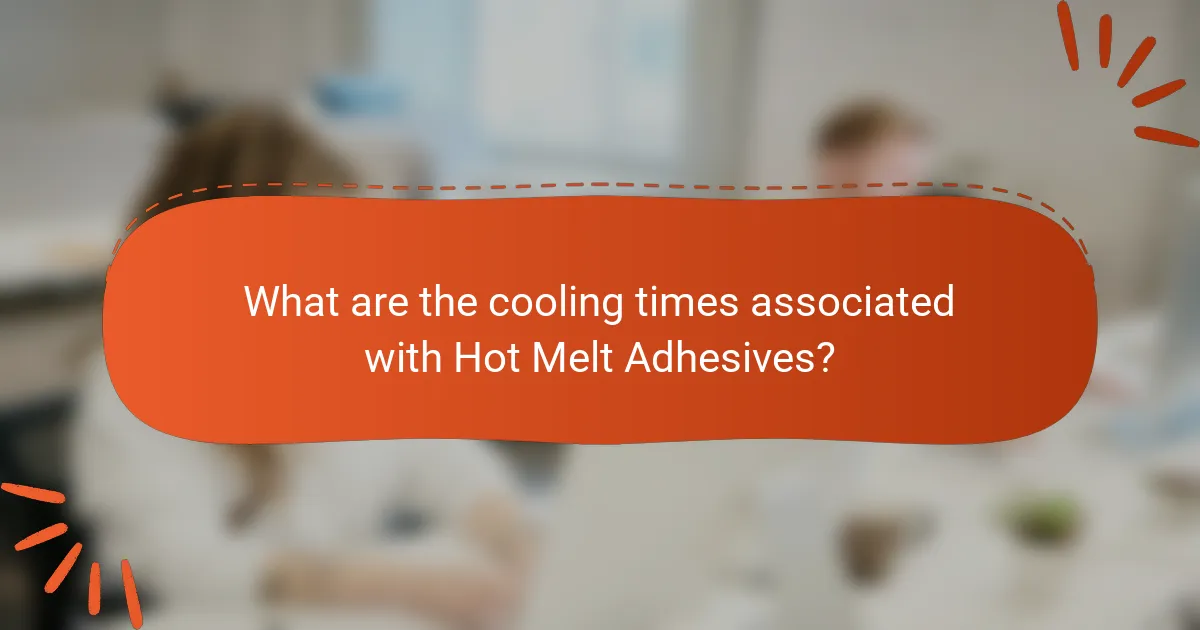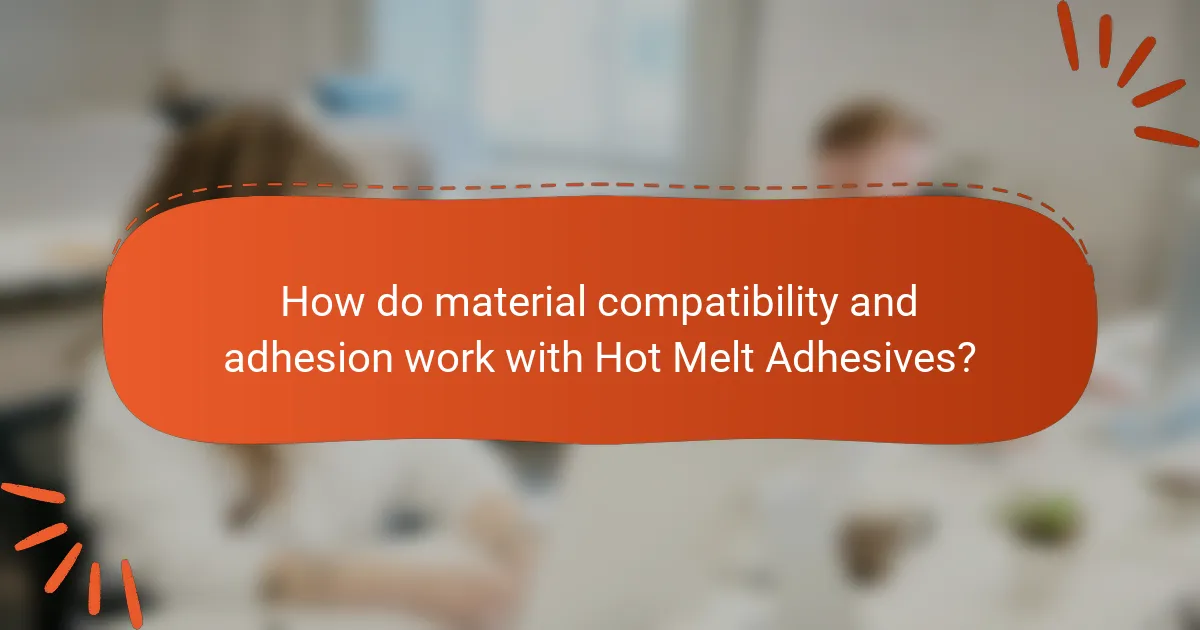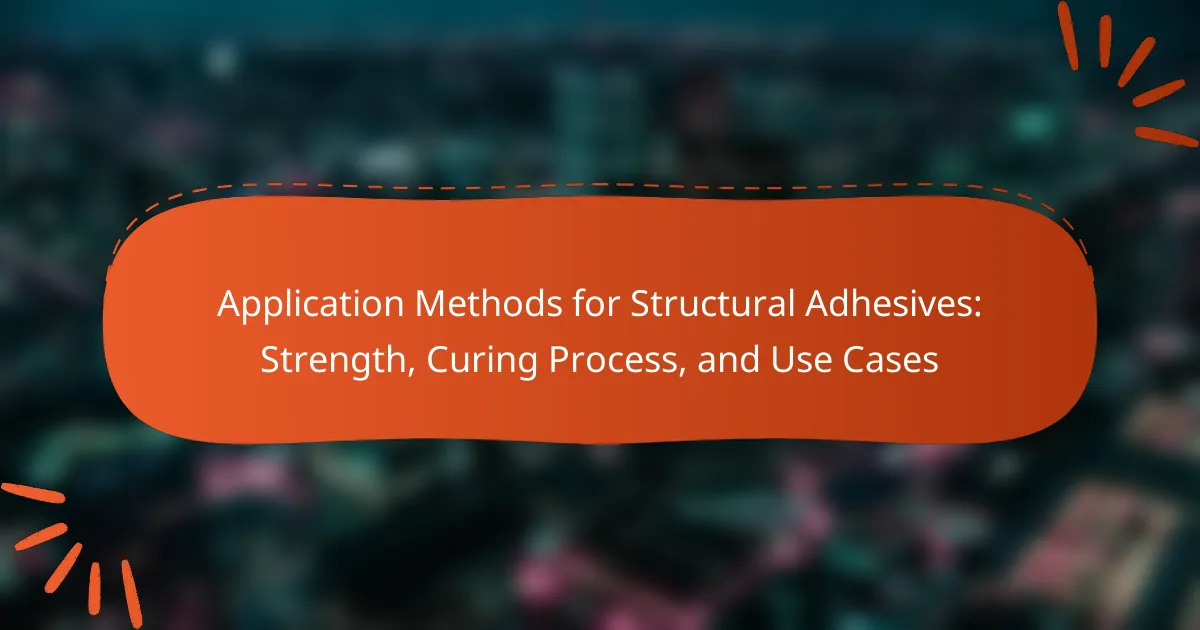Hot melt adhesives are thermoplastic materials that bond various substrates when applied in a molten state and solidify upon cooling. This article provides an overview of hot melt adhesives, detailing their application techniques, which include extrusion, spray, and roll coating, each suited for different manufacturing needs. It also discusses cooling times, which typically range from 10 to 30 seconds for handling and can take up to 24 hours for full curing, influenced by factors such as substrate material and ambient temperature. Additionally, the article covers material compatibility, emphasizing how the chemical composition of the adhesive affects adhesion to different surfaces, including the importance of surface energy and the necessity of surface treatments for optimal bonding.

What are Hot Melt Adhesives?
Hot melt adhesives are thermoplastic materials that are applied in a molten state and solidify upon cooling. They are commonly used in manufacturing and packaging industries for bonding various substrates. Hot melt adhesives offer strong adhesion, quick setting times, and versatility across different materials. They are available in various formulations to suit specific applications, such as packaging, woodworking, and automotive assembly. The solidification process occurs as the adhesive cools, creating a durable bond. Their ease of application and ability to bond dissimilar materials make them popular in production environments.
How do Hot Melt Adhesives work?
Hot melt adhesives work by melting a solid adhesive material and applying it in a liquid state. Upon cooling, the adhesive solidifies, creating a bond between surfaces. The melting point typically ranges from 100°C to 200°C. This process allows for quick setting times, often within seconds to minutes. Hot melt adhesives are thermoplastic, meaning they can be reheated and remolded. They adhere to a variety of substrates, including plastics, wood, and metals. Their effectiveness is due to the physical interlocking and surface wetting that occurs during application. This technology is widely used in packaging, woodworking, and automotive industries.
What are the key components of Hot Melt Adhesives?
The key components of hot melt adhesives are thermoplastic polymers, tackifiers, and additives. Thermoplastic polymers form the primary structure of the adhesive. Common polymers include ethylene-vinyl acetate (EVA) and polyamide. Tackifiers enhance the adhesive’s stickiness and improve bonding performance. Additives can include antioxidants, stabilizers, and colorants, which modify properties like viscosity and flexibility. Each component plays a crucial role in determining the adhesive’s performance in various applications.
How do temperature and viscosity affect Hot Melt Adhesives?
Temperature and viscosity significantly influence the performance of hot melt adhesives. Generally, higher temperatures reduce viscosity, allowing the adhesive to flow more easily. This improved flow facilitates better bonding with substrates. Conversely, lower temperatures increase viscosity, which can hinder application and bonding efficiency.
The ideal application temperature for most hot melt adhesives is between 350°F to 400°F. At these temperatures, adhesives achieve optimal viscosity for spreading and [censured]. For example, a study by the Adhesive and Sealant Council highlights that viscosity can decrease by 50% as temperature rises from 300°F to 350°F.
This relationship between temperature and viscosity is crucial for achieving strong, durable bonds in various applications. Proper temperature control ensures that hot melt adhesives perform effectively during application and curing processes.
What are the advantages of using Hot Melt Adhesives?
Hot melt adhesives offer several advantages, including quick setting times and strong bonding capabilities. They can bond a wide range of materials, such as plastics, wood, and metals. Hot melt adhesives are easy to apply, often requiring minimal equipment. They provide excellent resistance to moisture and temperature variations. Their versatility makes them suitable for various industries, including packaging and woodworking. Additionally, they are solvent-free, which reduces environmental impact. The ability to be re-melted allows for easy adjustments during the application process. Overall, hot melt adhesives enhance efficiency and effectiveness in adhesive applications.
How do Hot Melt Adhesives compare to other adhesive types?
Hot melt adhesives differ from other adhesive types in their application and performance characteristics. They are thermoplastic materials that become liquid when heated and solidify upon cooling. This allows for quick bonding, often within seconds to minutes. In contrast, solvent-based adhesives require evaporation of solvents, leading to longer curing times. Water-based adhesives also have extended drying times compared to hot melts.
Hot melts exhibit strong initial tack and bond strength, making them ideal for high-speed production environments. Other adhesives may not provide the same level of immediate adhesion. Additionally, hot melts are versatile and compatible with a variety of substrates, including plastics, wood, and metals.
Unlike some adhesives that may require specific surface preparation, hot melts often bond well without extensive treatment. They also have a lower environmental impact due to reduced volatile organic compounds (VOCs). In summary, hot melt adhesives offer speed, versatility, and ease of use compared to many traditional adhesive types.
What are the environmental benefits of Hot Melt Adhesives?
Hot melt adhesives offer several environmental benefits. They are solvent-free, reducing harmful emissions during application. Their rapid cooling time minimizes energy consumption in manufacturing processes. Hot melt adhesives are often recyclable, contributing to a circular economy. They also have a lower carbon footprint compared to traditional adhesives. Additionally, many hot melt adhesives are made from bio-based materials, promoting sustainability. Their durability reduces the need for frequent replacements, leading to less waste. Overall, these attributes make hot melt adhesives an environmentally friendly choice in various applications.

What application techniques are used with Hot Melt Adhesives?
Hot melt adhesives are applied using various techniques. Common application methods include extrusion, spray, and roll coating. Extrusion involves forcing the adhesive through a nozzle for precise application. Spray techniques allow for even coverage over large areas. Roll coating applies adhesive using rollers, ensuring uniform thickness. Each method offers unique advantages based on the specific application needs. For instance, extrusion is ideal for intricate designs, while spray is effective for broad surfaces. These techniques enhance the efficiency and effectiveness of hot melt adhesive applications.
What are the common application methods for Hot Melt Adhesives?
Common application methods for hot melt adhesives include extrusion, spraying, and roller application. Extrusion involves forcing the adhesive through a nozzle for precise placement. This method is often used for bonding large surfaces. Spraying allows for a fine mist application, suitable for uneven surfaces. Roller application spreads adhesive evenly across surfaces, ideal for flat materials. Each method is chosen based on the specific requirements of the project and the materials involved.
How does the choice of application method impact bond strength?
The choice of application method significantly impacts bond strength in hot melt adhesives. Different methods, such as spray, bead, or roll application, affect the distribution and thickness of the adhesive layer. Thicker layers typically result in stronger bonds due to increased surface contact. Conversely, uneven application can lead to weak spots in the bond. Studies show that optimal application techniques enhance adhesion by ensuring uniform coverage. For instance, a controlled bead application often yields higher bond strength compared to a spray method. Proper technique also influences cooling times, which are crucial for achieving maximum bond strength.
What equipment is typically used for applying Hot Melt Adhesives?
Hot melt adhesives are typically applied using specific equipment designed for this purpose. Common equipment includes hot melt glue guns, which heat the adhesive and allow for precise application. Another frequently used tool is the hot melt adhesive applicator, often utilized in industrial settings for larger-scale applications. Additionally, bulk hot melt systems are employed for continuous production processes, providing efficient application. These systems often include heated hoses and nozzles for consistent adhesive flow. The use of this specialized equipment ensures optimal performance and bonding strength in various applications.
How can application techniques vary by industry?
Application techniques for hot melt adhesives vary significantly by industry. In packaging, techniques often involve high-speed application to ensure efficiency. The automotive industry may utilize robotic systems for precise placement under strict quality controls. In woodworking, manual application techniques are common, focusing on bond strength and aesthetics. The textile industry often employs spray application for even distribution across large surfaces. Each industry adapts techniques based on material compatibility and production requirements. For instance, food packaging must adhere to safety standards, influencing adhesive choice and application methods. These variations ensure optimal performance and meet specific industry standards.
What are industry-specific techniques for using Hot Melt Adhesives?
Industry-specific techniques for using hot melt adhesives include precise temperature control, appropriate adhesive selection, and application method optimization. In packaging, for example, maintaining a nozzle temperature of 350°F ensures optimal bonding. In woodworking, using a polyurethane-based hot melt adhesive enhances water resistance. The automotive industry benefits from using reactive hot melts that cure under heat, providing strong joints. In textiles, applying adhesives through spray or roller methods allows for even distribution. Each technique is tailored to the material compatibility and application requirements specific to the industry.
How do application techniques differ between manual and automated processes?
Application techniques for hot melt adhesives differ significantly between manual and automated processes. Manual application involves hand-held tools, such as glue guns, allowing for precise control in small-scale applications. This technique is often slower and requires skilled operators to achieve consistent results. In contrast, automated processes utilize machinery for high-speed application, ensuring uniformity across larger production runs. Automated systems can apply adhesives at a consistent temperature and pressure, reducing the risk of human error. Studies have shown that automated application can increase efficiency by up to 50% compared to manual methods. The choice between these techniques often depends on production volume and specific project requirements.

What are the cooling times associated with Hot Melt Adhesives?
Cooling times for hot melt adhesives vary based on the specific formulation and application conditions. Typically, initial cooling times range from 10 to 30 seconds for handling. Full curing can take anywhere from 1 to 24 hours, depending on the adhesive type and environmental factors. Factors such as substrate materials and ambient temperature also influence these times. For example, some hot melts may cool faster on metal surfaces compared to porous materials. Understanding these cooling times is crucial for optimizing bonding strength and assembly efficiency.
How do cooling times affect the bonding process?
Cooling times significantly impact the bonding process in hot melt adhesives. Adequate cooling allows the adhesive to set and achieve optimal bond strength. Insufficient cooling can lead to weak bonds and increased likelihood of failure. The cooling rate influences the viscosity of the adhesive as it transitions from a molten state to a solid state. Slower cooling often results in better adhesion due to improved interfacial contact. Conversely, rapid cooling may trap air or create voids, weakening the bond. Studies show that optimal cooling times enhance adhesive performance and durability, confirming the importance of this factor in bonding applications.
What factors influence the cooling time of Hot Melt Adhesives?
The cooling time of Hot Melt Adhesives is influenced by several factors. These factors include the adhesive formulation, ambient temperature, and thickness of the adhesive layer. The formulation determines the melting point and cooling characteristics. Higher ambient temperatures can reduce cooling time, while lower temperatures prolong it. Additionally, thicker adhesive layers take longer to cool than thinner ones. The type of substrate also impacts the cooling time due to its thermal conductivity. Materials with higher thermal conductivity absorb heat more quickly, resulting in faster cooling.
How can cooling time be optimized for different applications?
Cooling time can be optimized for different applications by adjusting several factors. First, controlling the ambient temperature can significantly impact cooling rates. Higher ambient temperatures may prolong cooling times, while lower temperatures can expedite the process.
Second, the thickness of the adhesive layer can influence cooling duration. Thicker layers typically require more time to cool than thinner applications.
Third, selecting the right adhesive formulation also affects cooling time. Some hot melt adhesives are designed for faster cooling, which can be beneficial in high-speed production environments.
Additionally, using cooling methods like forced air or water cooling can reduce cooling times effectively. Studies show that forced air cooling can cut cooling time by up to 50% compared to natural cooling methods.
Lastly, optimizing the application technique, such as using proper nozzle sizes and application speeds, can enhance heat dissipation. This approach can lead to shorter cooling times while maintaining bond strength.
What are the consequences of improper cooling times?
Improper cooling times can lead to several negative consequences in hot melt adhesive applications. Insufficient cooling may cause weak bond strength. This can result in premature failure of the adhesive joint. Excessive cooling times can lead to overheating of substrates. Overheating may damage sensitive materials, compromising their integrity. Additionally, improper cooling can introduce stresses in the adhesive. These stresses may lead to cracking or delamination over time. Consistent cooling times are essential for optimal performance and durability. Studies show that adhering to recommended cooling times enhances bond reliability and longevity.
How does cooling time impact the strength of the bond?
Cooling time significantly affects the strength of the bond in hot melt adhesives. Insufficient cooling time can lead to weak adhesion. This occurs because the adhesive may not reach its optimal solidification state. Conversely, allowing adequate cooling time ensures that the adhesive forms a strong, durable bond. Research indicates that bonds cured for longer periods exhibit greater tensile strength. The ideal cooling duration varies depending on the adhesive formulation and application conditions. For example, a study by the Adhesive and Sealant Council found that a cooling time of 30 seconds significantly improved bond strength in certain hot melt adhesives. Therefore, managing cooling time is crucial for achieving maximum bond strength.
What troubleshooting steps can be taken for issues related to cooling times?
To troubleshoot issues related to cooling times of hot melt adhesives, first check the application temperature. Ensure the adhesive is applied within the manufacturer’s recommended temperature range. Next, assess the thickness of the adhesive layer. Thicker layers generally require longer cooling times. Evaluate the ambient temperature and humidity, as high humidity can prolong cooling. Inspect the substrate materials, as different materials may absorb heat differently. Ensure that the adhesive is not contaminated, as impurities can affect performance. Finally, verify the equipment used for application, as inconsistent heating can impact cooling efficiency. Each of these steps addresses common factors that influence cooling times in hot melt adhesives.

How do material compatibility and adhesion work with Hot Melt Adhesives?
Material compatibility and adhesion in hot melt adhesives depend on the chemical composition of the adhesive and the materials being bonded. Hot melt adhesives are thermoplastic polymers that, when heated, become liquid and can adhere to various substrates. The effectiveness of adhesion is influenced by surface energy, porosity, and the presence of contaminants.
High surface energy materials like metals and glass bond well with hot melt adhesives. Low surface energy materials, such as polyethylene, may require surface treatment for optimal adhesion. The adhesive penetrates the surface of the substrate, creating a mechanical bond as it cools and solidifies.
Studies show that proper temperature control during application enhances adhesion. For example, if the adhesive is too cool, it may not flow adequately into the substrate. Conversely, excessive heat can degrade the adhesive properties.
The compatibility of the adhesive with the substrate can be tested through peel and shear strength tests. These tests provide quantitative measures of the bond strength achieved between different materials and hot melt adhesives.
What materials are compatible with Hot Melt Adhesives?
Hot melt adhesives are compatible with various materials. Common compatible materials include wood, paper, cardboard, and certain plastics like polypropylene and polyethylene. They also bond well with metals and ceramics. The adhesive forms strong bonds by melting and cooling, creating a solid connection. This versatility makes hot melt adhesives popular in packaging, woodworking, and assembly applications. Their effectiveness across different substrates is well-documented in industry standards.
How does surface preparation affect adhesion with Hot Melt Adhesives?
Surface preparation significantly impacts adhesion with hot melt adhesives. Proper surface preparation enhances the adhesive bond by increasing surface area and removing contaminants. Clean and roughened surfaces allow for better [censured] of the adhesive. This leads to improved mechanical interlocking. Studies show that surfaces free from dust, oil, and moisture achieve stronger bonds. For instance, a clean surface can increase adhesion strength by up to 50%. Inadequate preparation can result in weak bonds and premature failure. Therefore, effective surface preparation is crucial for optimal performance of hot melt adhesives.
What are the challenges of bonding dissimilar materials?
The challenges of bonding dissimilar materials include differences in thermal expansion, chemical compatibility, and surface energy. These differences can lead to stress concentrations and potential failures in the bond. For instance, materials with varying coefficients of thermal expansion may expand and contract at different rates, causing the adhesive bond to weaken. Additionally, if the materials have incompatible chemical properties, the adhesive may not adhere properly. Surface energy plays a crucial role as well; low-energy surfaces may require special treatments for effective bonding. Research indicates that these factors significantly influence the performance of adhesives in practical applications.
What testing methods are used to assess material compatibility?
The testing methods used to assess material compatibility include peel tests, shear tests, and tensile tests. Peel tests measure the adhesive strength between two materials when they are pulled apart. Shear tests evaluate the resistance to sliding forces between bonded materials. Tensile tests determine the maximum stress a material can withstand while being stretched.
These methods provide quantitative data on how well materials adhere to each other. For example, peel tests can reveal the effectiveness of a hot melt adhesive on different substrates. Shear and tensile tests can indicate the durability of the bond under various conditions.
Using these methods ensures that the chosen adhesive is suitable for the intended application. They help predict the performance of the adhesive in real-world scenarios, ensuring reliability and safety in use.
How can adhesion tests inform the choice of Hot Melt Adhesives?
Adhesion tests can significantly inform the choice of Hot Melt Adhesives by evaluating their bonding effectiveness. These tests measure the strength and durability of the adhesive bond under various conditions. For instance, peel tests assess how well the adhesive adheres to different substrates. Shear tests evaluate the adhesive’s resistance to sliding forces.
The results from these tests guide manufacturers in selecting the appropriate adhesive formulations for specific applications. They help in determining factors such as temperature resistance and environmental conditions the adhesive will face.
For example, if an adhesion test shows high performance on a specific material, it indicates suitability for that application. Additionally, adhesion tests can reveal potential weaknesses, allowing for adjustments in adhesive formulation. This ensures optimal performance in real-world conditions, ultimately leading to better product reliability.
What are best practices for ensuring material compatibility?
Best practices for ensuring material compatibility include conducting thorough material assessments. Identify the properties of each material involved in the application. Test adhesion on sample materials before full-scale application. Evaluate environmental factors such as temperature and humidity. Use adhesives specifically designed for the materials in question. Consult technical data sheets for compatibility information. Document results from compatibility tests for future reference. These practices help prevent failures in bonding and ensure effective application of hot melt adhesives.
What practical tips should be considered when using Hot Melt Adhesives?
Use hot melt adhesives at the recommended temperature for optimal bonding. This temperature typically ranges from 250°F to 350°F, depending on the adhesive type. Ensure surfaces are clean and dry before application. Contaminants can weaken the bond significantly. Apply the adhesive evenly for consistent coverage. Uneven application can lead to weak joints. Use appropriate dispensing equipment for precision. Manual application can result in excess adhesive and mess. Allow adequate cooling time for the bond to set properly. Cooling times can vary based on adhesive type and environmental conditions. Store hot melt adhesives in a cool, dry place to maintain their effectiveness. Proper storage prevents degradation and extends shelf life.
Hot melt adhesives are thermoplastic materials that bond substrates by being applied in a molten state and solidifying upon cooling. This article provides a comprehensive overview of hot melt adhesives, detailing their application techniques, cooling times, and material compatibility. Key components such as thermoplastic polymers and tackifiers are discussed, alongside the impact of temperature and viscosity on adhesive performance. Additionally, the article examines the advantages of hot melt adhesives, compares them to other adhesive types, and outlines best practices for ensuring effective bonding across various materials.


